Behind the brand: Keva Marie Dine of Poot!
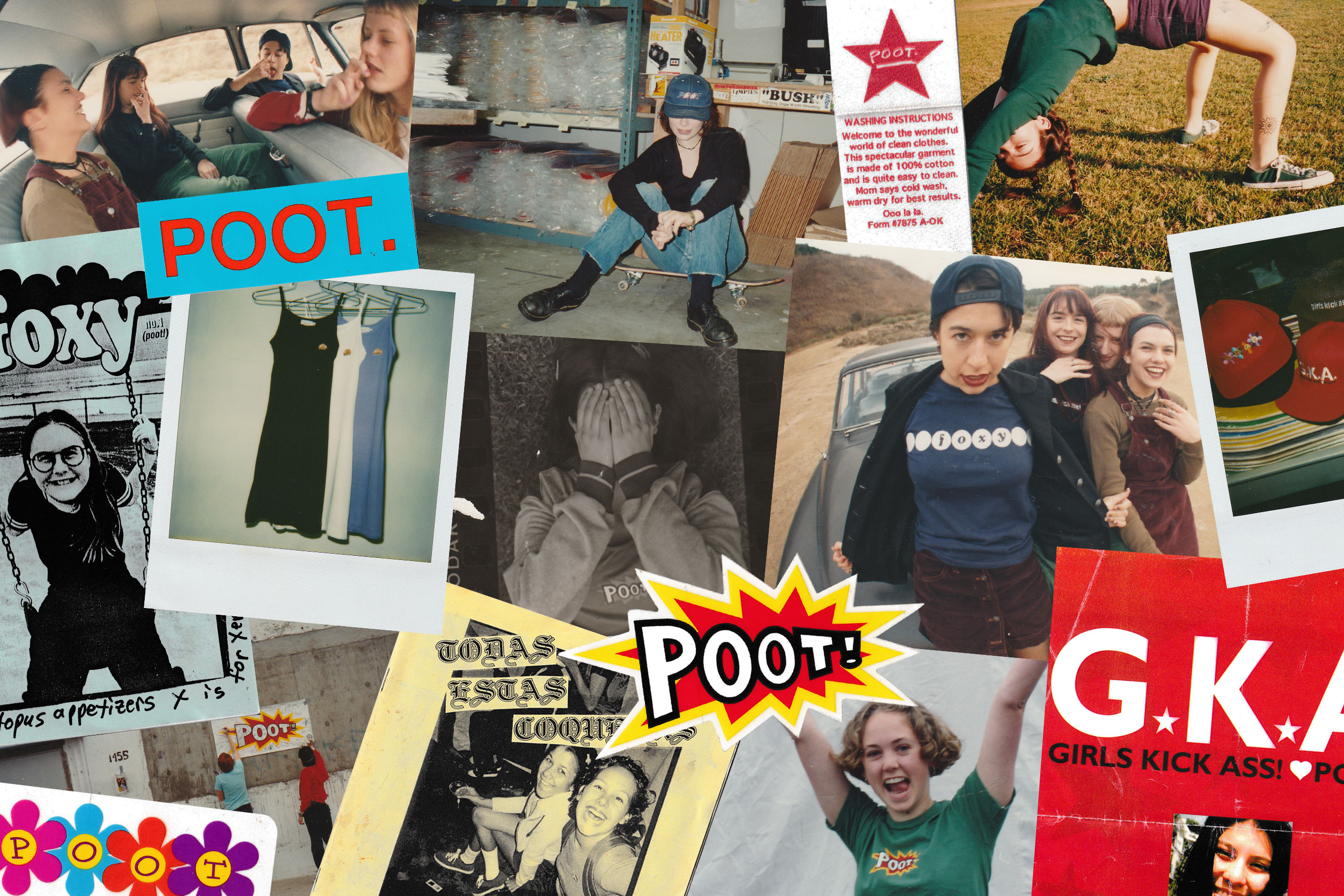

Keva Marie Dine shared the full story of the early 90s girls skate brand she co-created, which mustered a cult following and paved the way for brands to come.
It’s important to know your roots. With more and more women’s brands emerging in skateboarding, it seems like a good time to uncover the story about one of the very first girls skate brands.
Though Poot! may have been short lived, it paved the way for women’s skate brands to come, showing the industry that girls were a part of skateboarding too. What began with a simple Poot! t-shirt graphic grew into a full cut and sew range, a shoe line (Choes), and a full-color magazine (Foxy) — all for girls. For such a pioneering brand, it’s a wonder that so little is known about it now.
Poot! was before my time — I was just starting to push up and down the street when the brand came to an end. Over the years I’ve stumbled upon the occasional mention of it in the Slap message boards and on social media but despite digging through the world wide web there was little to be said about the brand. Poot! saw its final days around the time the Internet entered our homes, which means that much of the brand’s story remained confined to shoeboxes full of magazine clippings and photos.
It was the #pootgirl hashtag that lead me to Keva Marie Dine, the co-creator of the brand. A few DM’s and emails later and we were on the phone talking through the highs and lows of being a woman working behind the scenes in skateboarding in the early 90s. This is her story about that time, from the very beginning of Poot! until the end.
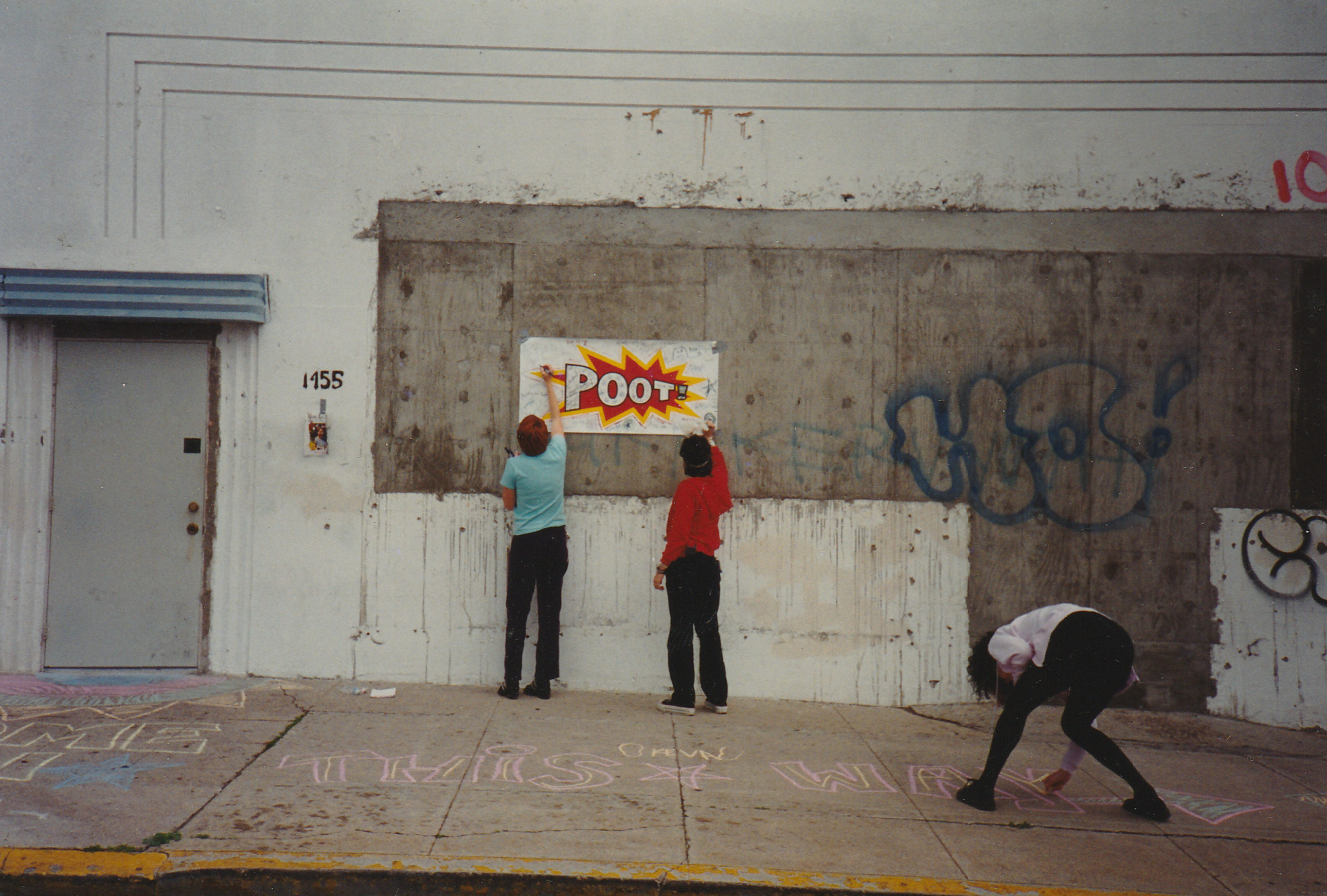
You started Poot! when you were 21 years old in 1991. What was going on in your life at that time?
I was living in Solana Beach in San Diego where I’m from. I was waitressing and taking classes on fashion illustration, marketing and economics at a local college. I had started my own line of clothing called “Keva Marie” — Marie being my middle name. It wasn’t my first line of clothing. I had done this a couple of times in my childhood and as a teenager. I was making hats and these wrap-around tops and dresses and selling them to a lot of local hipster stores. I had a bit of a name for myself.
Around the time Poot! started I was cranking out clothes and hustling and I would wear my clothes everywhere. I was pretty cute [laughs]. I had hired a friend of mine, Heather, who was a seamstress. I could kind of sew but wasn’t really good at it. I was better at directing people who had the actual skills. So I would source all the materials and she would make the dresses. A lot of them were made out of curtains and bedspreads that I would find at thrift stores. I had so much fun doing that.
Were you involved in skateboarding at that time?
I didn’t really know tons about skateboarding but I guess if I think back, maybe I was just so used to it because I grew up in Cardiff. My best girlfriend and I, Tricia Kay-Fambro used to go to the Del Mar Skate Ranch and jump on the trampolines and watch her cousin Rex Kay (RIP) and all the boys skateboarding. There weren’t any girls skating. Maybe Lori Rigsbee might have been there but I didn’t know it at the time. So although I say I didn’t know a lot about skateboarding it was just part of our culture. It was everywhere and it was ingrained.

How did Poot! first begin?
My boyfriend at the time, Greg Goodfellow, was semi-sponsored by Foundation. He wanted to pick up some product so we went down to the warehouse in Sorrento Valley and that’s where I met Tod Swank, the owner of the company. Tod was showing us around and I went into the warehouse and was like, ooooh, what is going on here? The warehouse wasn’t impressive or anything but I just saw all this potential. I was always very business-y and just wanted to do stuff and, like, start a business.
I was very style-y and full of energy. I was probably wearing one of my dresses and hats at the time. Tod started talking to me like, oh you do fashion? You do clothes? He was asking me all these questions.
All the brands back then made t-shirts and were screen printing designs, but around that time Plan B and Duffs and these other companies were just starting to get into cut and sew. It’s all very foggy now and I don’t remember exactly what happened but Tod was interested in getting into clothes — like actual cut and sew pants and stuff — and I knew girls clothes but I also knew a thing or two about clothes in general. I also knew about marketing, and I had the energy and I was just really into it. It was all very natural, the energy and interest were there, the opportunity was there. Tod was like oh you do clothes. I want clothes. I have a company. You know what you’re doing. Let’s just do it. And I was like, ok, cool! We had mutual motivation and I’ve always had a lot of gumption and strength in follow through… so I followed up, grabbed the lead and took it seriously.
“We sourced this pair of jeans from the big and tall store and I sewed inserts into each side to make them even bigger and created this kind of famous ad.”
So he wanted you to work on the Foundation clothing line?
Yeah but then we also wanted to start doing girls clothes because that’s what I was doing. Tod already had the name — Poot! It was so irreverent and random. It means farting which I thought was kind of crass and he was like, yeah but, you know… skateboarding. I thought of it in like a, [giggle] Poot! [giggle], kind of way.
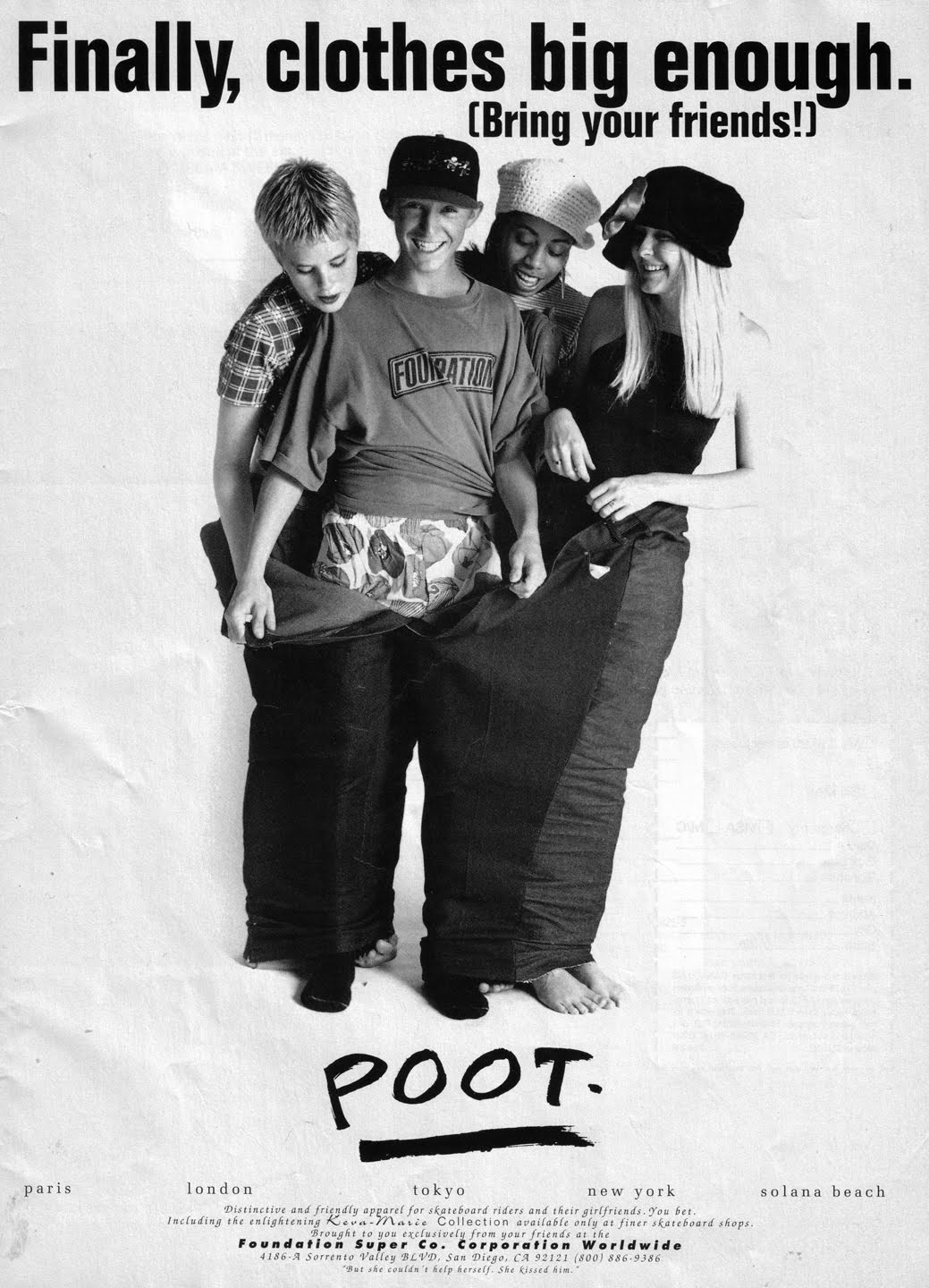
What was the first thing you did with Poot!?
One of the first things we did was a photo shoot. Around the time we decided to do Poot! we were also brainstorming what the Foundation pants should look like.
Back then it was always about the monthly ad in Big Brother or Transworld. It was where you’d see all the cool new things that companies were doing and who the new team riders were, so people would obsess over it. We were coming up with ideas that we wanted to do with Foundation and sketching out what the pants should look like. He was showing me what other people were doing with their pants and how everything was XXL. X-Large [the brand] was a thing then. And there was lots of Freshjive and they were all big clothes — like stupid big oversized tees and baggy ass pants full on hanging off… totally ridiculous. The boys looked like babies wearing adult clothes. I had no idea how they actually, you know, skated in them. A lot of the time in skateboarding, brands would sort of make fun of the other companies in their ads like a joke… it was a thing. We were concepting the Foundation pants, designing them for the skaters so they weren’t so huge and they could skate in them. Tod had this idea that we should make fun of how all the clothes were super fucking big and so ridiculous.
We came up with this idea for an ad with Ronnie Creager. We sourced this pair of jeans from the big and tall store and I sewed inserts into each side to make them even bigger and created this kind of famous ad. It was Ronnie Creager and three of my Poot! Girls, as we’d call them, and they all got inside the pants. It was so funny! The girls were wearing my hats and some of my clothes that I was doing. And so that’s when we announced that Foundation was going to start making clothes for girls, in fine print at the bottom of the ad.
Robin Wright was one of the girls in the ad. She and I took classes together and I just called her up and asked her if she wanted to be in this ad for a skateboarding company. We did another ad with Robin in it, introducing the girls line maybe a month or two later. She was wearing one of my dresses and she had a little “Poot!” next to her as if she did a little fart [laughs]. I was like, oh my god this is so ridiculous. But it totally worked and there was all this buzz, like, wait a minute. You’re doing clothes for girls? It was sort of unheard of and that was a huge part of what made it so special. It didn’t exist.
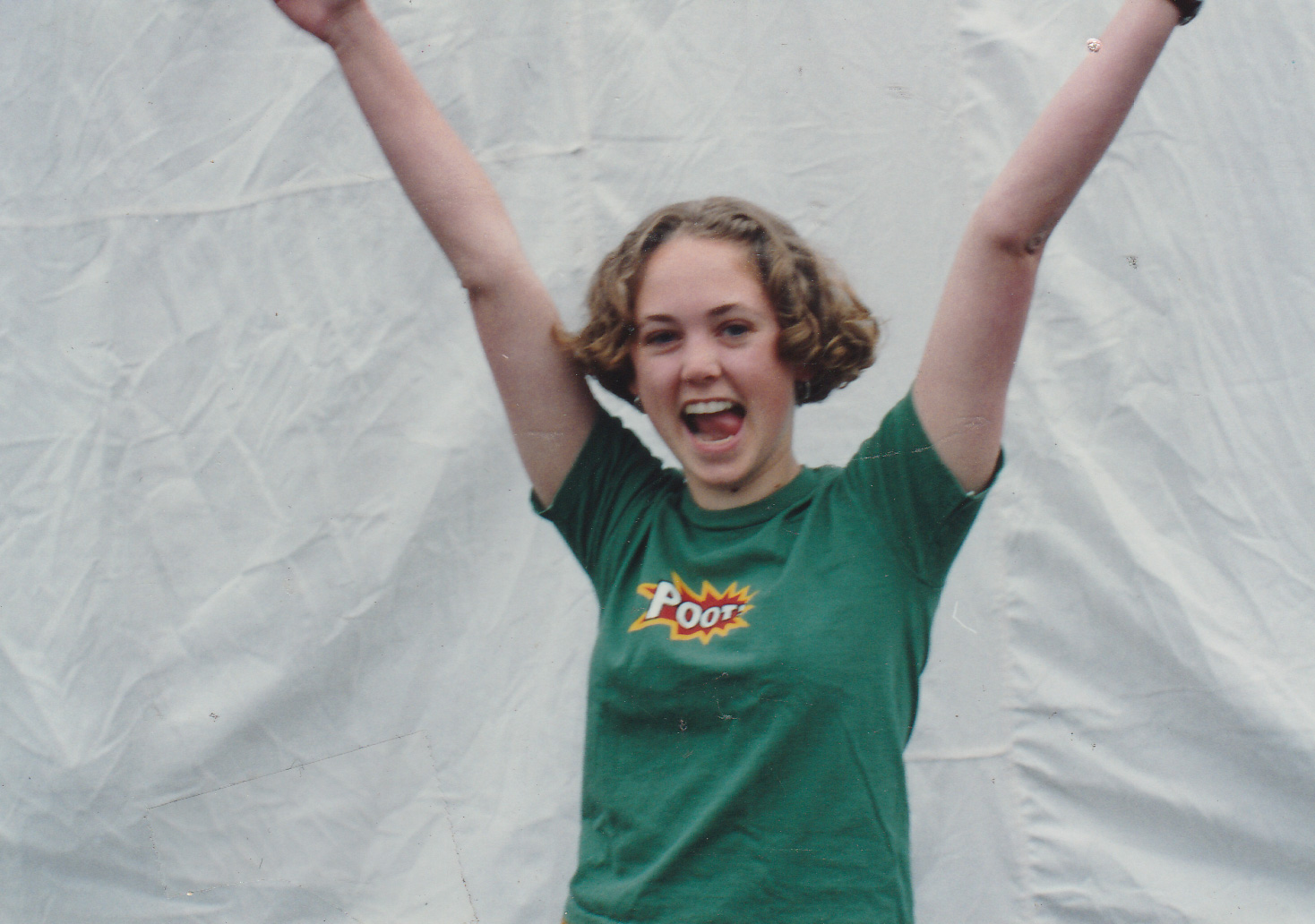
Was X-Girl around at the time?
No, X-Girl came later. This was pre X-Girl and pre Roxy. I love Kim Gordon and Daisy von Furth and Sophia Coppola too [the X-Girl founders]. But Poot! came first. So take that girls! But X-Girl had famous people behind them. They had Spike [Jonze] and they had Beastie Boys. But we were first and being first was really hard. Poot! was born out of no rules, like, let’s just wing it and do it.
So did you go straight into cut and sew products with Poot! or did you start with the printed t-shirts?
Hmm, we might have had the explosion logo t-shirt first and then went into cut and sew. And then that became my job. I quit my job waitressing but I was still going to school. There was a while when I was doing double shifts and Tod would come over to my studio where I had my sewing machine and we would come up with ideas for the clothes. I was sewing pant samples and we were doing a lot of research. It was a really creative time. We clicked really well and we had so many ideas. I was thinking, wow, this is what it’s all about when you get a grown up job and work somewhere really creative.
One of the first things we actually did under the Poot! brand was the Poot! hot pants, which were like short-shorts. It’s amazing because that’s how I met one of my longest friends now. Her name is Shaney Jo and she runs the Keep A Breast non-profit organization. She was working across the street from where I was waitressing. I knew she went to FIDM so I tracked her down in the street and asked if I could hire her to make the pattern for the shorts.

I was talking to Kevin from Lookback Library about Poot! He mentioned that Mike Youssefeour — who worked as a shipper in the warehouse — said he knows what a french cut top is thanks to you. What was it like running a women’s brand out of a major skate distribution company back then?
I love that so much! Mike’s a rad guy. But to be honest it was rough for me back then. I’d go into the warehouse where all the guys were — and they were like legit bow-down-respect-skateboarders working in the industry — and they just didn’t really like me. They were like, why are you here? Why am I taking direction from you? You’re just a girl. But there I was working double shifts, designing pants for the guys, and the Poot! tees and hot pants, and creating ads with Tod. I had a mission, but it still was bad vibes for a while.
Back then it was just a really big protected boy-gang. The boys weren’t receptive. Tod was because he was such an innovator and he saw potential. But there were some people in the warehouse who didn’t want to take direction from a girl and they wouldn’t even listen to me. They would just walk away from me and not even engage in conversation. I was just not accepted. But on we went and I just had to go through it because Foundation was growing. Like growing! It was gaining popularity, selling more… it was rapid growth. Tod was hiring more people. He hired Kendra Gaeta who my sister knew growing up. She managed sales and was like a superstar in the industry — like a cult following, really — and she kicked ass! We’re still friends now.
“… there were some people in the warehouse who didn’t want to take direction from a girl and they wouldn’t even listen to me. They would just walk away from me and not even engage in conversation.”
What were the sales like? Was it difficult getting a girls brand into skate shops?
We had long-standing relationships with the skate shops but when we told them about Poot! they were like, what are we going to do with girls clothes? So it was frustrating and upsetting but I didn’t quit.
Did it motivate you more?
It did because it felt… wrong. The whole concept of the girls line was that it was designed for the “real girl.” The girl that you would see down the street. It wasn’t supposed to be fashion-forward. It was supposed to be really comfortable basics that fit really well and were fun. I went to the skate shops and was doing market research and it was just filled with boy clothes. More and more brands were starting to do cut and sew boys clothes but there were still no girls clothes. I remember Kendra couldn’t sell any of them, but she was relentless and never gave up. She made it her mission and just kept pushing the Poot! stuff after they did their Foundation orders. Really, it felt unjust and it was making me really frustrated.
I didn’t identify it like this back then but I felt enraged as a feminist. All these girls were around and they were going to skate shops and skate parks. They were skating and hanging out. It wasn’t like there were no girls. We were everywhere.
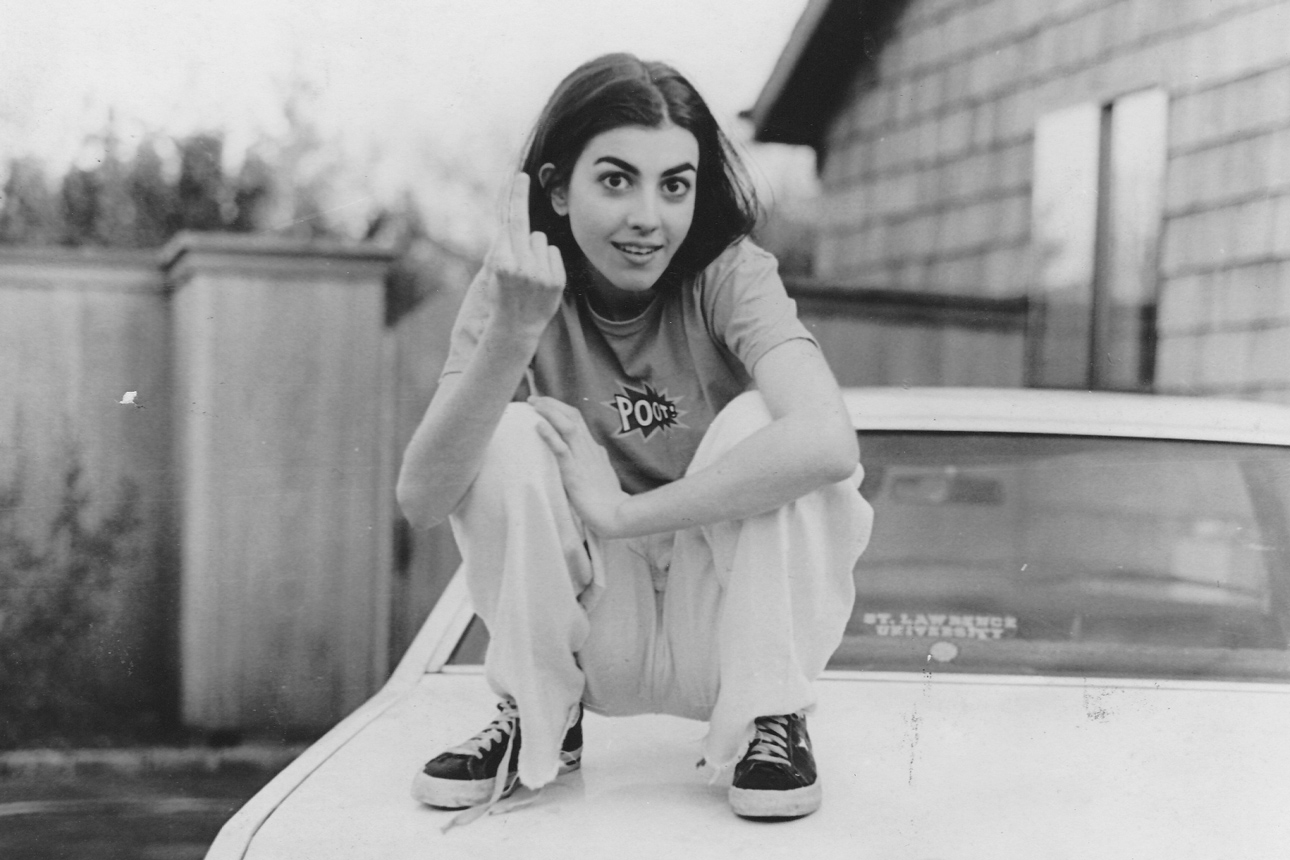
Poot! became really successful though. A friend of mine, Chad Ford, who worked at a skate shop in Australia back then said that when they would order in Poot! product it would sell out straight away. So where was the shift? When did it start to take off?
We were relentless in pushing it because we knew it was so fun and that it was going to catch on. But nobody would buy anything for the longest time until Slam City Skates in London started buying it. This must have been around 1992 or ‘93. They got it! There was this super rad girl who worked there whose name was Sharon and she would buy the clothes. We met years later when she came out for ASR in San Diego and it was like, of course you’re awesome, of course we’re friends. Sharon rocks. They were selling out like crazy! It was because it was making a statement. It was like, we’re here too and we’re part of this. These are our clothes and they’re sort of sassy and we’re sort of sassy. It had attitude but it wasn’t offensive. It was fun, and it was real, and wearing your Poot! tee became like a statement piece. Going to events and seeing girls with Poot! stuff made me so happy and so moved. Really, there’s almost nothing that’s come close to that feeling of accomplishment… of having that positive impact.
I saw all these girls that weren’t being represented and I wanted to give them a movement and their own thing. I was like, we’re here too, boys! We had buying power and we wanted to wear cute stuff and be part of this scene because it was so, like… I don’t know, we just made our own rules. If you thought of it and you dreamt it, and you had the talent and the drive, you could just do it. And it was so cool to be around.
Did Poot! ever have a skate team? Who were the “Poot! Girls”?
So Poot! Girls were girls that I would track down that were part of the scene or girls I worked with. There was a certain type of energy that a Poot! Girl had. Kind of like the “real girl.” I remember going to the movies and there was this girl working behind the counter named Ivy. She was kind of dorky and had her glasses and was being adorable. And I was like, oh my god, you need to be in a photo shoot! And she was like, me, a model? Are you kidding? But she was rad — is rad! Hi Ivy! — and she had her own style and wasn’t mainstream. She was non-conformist and just real.
There was something about putting some of these girls in the catalogue shoot because they were so real. They weren’t trying to be anything but themselves. They weren’t like Seventeen Magazine girls, all polished. And they weren’t bubblegum cheerleader girls. But they liked fashion and they hung out at the skate shops and were in the scene. There was something about it that was a little bit free. These girls would just light up and get so excited and they became this crew. I think it was around that time that Deanna Templeton called me. She was one of the only girls at the time that was in a position in skateboarding where she was totally respected.

What was Deanna doing at the time?
She was traveling all over the world with Ed. I don’t think she was shooting or publishing her photography at the time. I think that came later. But she was the one who was traveling everywhere and saw everything.
Deanna called me — I think she was on tour with the Toy Machine team — and she said she saw these stickers that said “Skateboarding Kicks Ass.” She suggested that we make stickers that say “Girls Kick Ass.” And I was like, yeah girls do kick ass! I remember running down the hallway back to Mike Nelson, our Senior Graphic Designer in the art department, to tell him we have to make these stickers. It was sort of just our attitude — we kick ass too! It was like a badge. The guys would have their t-shirts with the logos of their sponsors and that was their street cred. But then the girls had their Poot! t-shirts and their Girls Kick Ass t-shirts and it was like, yeah, well we’re Poot! Girls and we’ve got something to say too!
Poot!’s “Girls Kick Ass” slogan definitely speaks to your feminist side. Were you surprised that the slogan gained so much traction around the world?
No, we just knew. Sometimes you do something and you get the tingles when it’s the right time, right place. The t-shirts and stickers just went nuts. It just felt right and we were just claiming our stake, that we mattered and we were part of this, even if it was just that we were supporting it.
I remember going to Rusty’s in Del Mar and they had a whole Poot! line hanging on the racks. I was so excited and thought, this is the way it should be! But it took a long time.

When Poot! started to take off, that was when you started Foxy, right?
What was happening was, Poot! was getting so much fan mail. Girls started mailing and faxing letters to the warehouse and it was amazing. Piles really. Kinda the best thing ever!
Zines were a big deal back then. Huge! In the late 80s and early 90s everyone was making zines and a lot of the skateboarders and artists in the scene were really well known for their zines. Tod was also in the zine scene so it might have been his idea, but we just took all of these letters and instead of writing everyone back we made these black and white zines on the Xerox machine and sent it back to everybody. We would put together articles and ads and used the Xerox machine to mash it together.
It totally clicked for me because when I was about 10 or 11 I made a little newspaper called Kids World. I was always interested in people and interviewing people. It’s funny because now I’m a recruiter and I do the same thing. I used to walk down the street in Del Mar where my dad’s office was and interview people in the street and then make this little magazine and sell it on the street for like 10 cents or something. I just loved knowing about people and what excited them.
So getting all the fan mail really spoke to me. The girls would send pictures of themselves wearing their Poot! clothes. It was amazing! We started incorporating those into some advertising ideas. We did a “real girls model search” ad encouraging girls from all over the world to send a photo of themselves wearing the Girls Kick Ass t-shirt. We put them into the zine and then mailed the zines out and put them in the orders.
Miranda Bressman Ritchie, who was working in sales with Kendra, came into my office one night. I was cutting and pasting pictures that girls had sent in and trying to figure out how I could make it into a little zine. We were brainstorming what to call it and I remember her standing there and being all like, there’s Sassy Magazine and we’re sassy… what about Foxy? And I was like, oh my god, that’s it! So that’s how Foxy was born. We could never trademark it because there’s this Foxy lettuce.
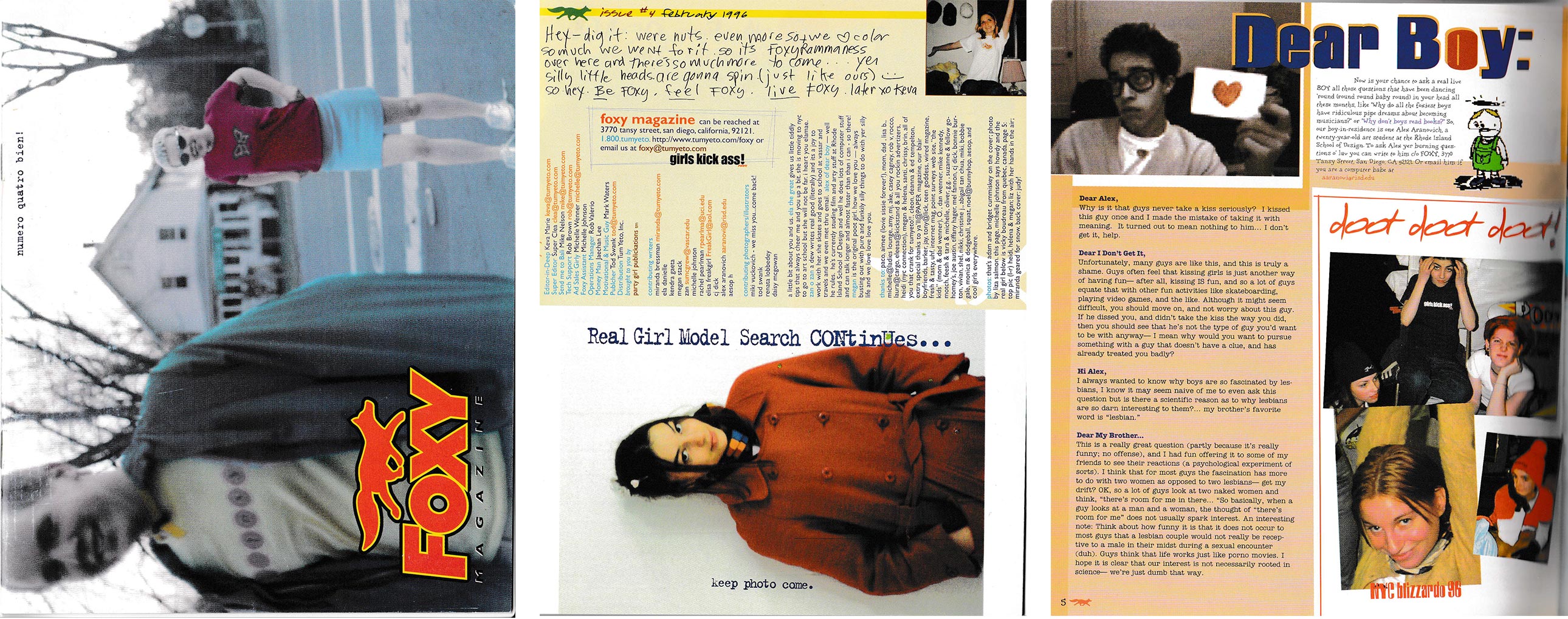
I’m going to come back to that in a second actually. How many issues of the black and white zine did you do?
We did three and then it went color and then it went online. We did 2 or 3 issues printed in color but the last one I wasn’t a part of because I was fired [laughs]. So I think I missed that one. But yeah, we did about three issues of the Foxy zine and it was so much fun. I fricken loved it! By the time it went to color I was able to get Urban Outfitters to ship it to their stores to hand out because I made friends with one of their founding creative directors. It wasn’t mass produced but it was legit. Everyone wanted to be in it and be a part of it. When it got bigger we had to hire more people and that’s when Tod hired Clea Hantman, AKA Super Clea.
“… we got the attention of quite a lot of people because it was pretty early days for that kind of thing on the internet.”
The writer?
Yeah, she was a legit writer and was working for magazines. Tod hired her and she became the official editor. I was the editor at large but she was the official editor. I think that’s when Miki Vuckovich started working there too. He’s such an amazing photographer. He actually shot the photos at my wedding! He shot the Poot! fashion shows and got one of the best pics ever!
When we put Foxy online it was called a web zine. Wired Magazine came out and did a photoshoot with Clea and I and we got the attention of quite a lot of people because it was pretty early days for that kind of thing on the internet.

Coming back to the lettuce… there’s a vegetable and farming company called Foxy and they use the same logo as Foxy Magazine. What’s the connection there?
So remember how I said that skateboarding in the early 90s was just like, fuck it, let’s just do it and be bold and rip stuff off? You know, it was easier to beg forgiveness than ask for permission. We were just a small little company so we probably just took it from them and altered it. I think they were around forever. We were just wild. We were having so much fun and just rolling with it. We were Foxy. We didn’t care about some lettuce!
I dug back into the web archives and found the old Foxymag.com website. You had some amazing content.
People just loved Foxy. There was this fan boy, Alex Aranovich, and he would send in letters all the time. He was studying at RISD and maybe 19 years old. I gave him a column called “Dear Boy” and it was so cute. Girls would ask for advice or something. I don’t know [laughs]. I remember Clea wrote some articles about how to tune up your car and stuff like that.

And then around 1994 you started the shoe line called Choes, right?
It was sort of toward the end. We called it “Choes,” pronounced like c-h-o-o-s-e. It was meant to be how a little kid would say “shoes.” I did an ad where I took a pair of my shoes and crafted them and bedazzled them into some sort of ridiculous platform sneaker with the skateboard wheels attached to the bottom. We only did one run of shoes and it was through Duffs. Duffs was Steve Rocco’s brand and he really liked me. He was Tod’s mentor/nemesis… I don’t know [laughs]. We did one run and that was it.
Were they successful?
I don’t think so. I don’t think they were as successful as they could have been but it was probably too early to tell. We ran out of runway though because then I was fired.
“I just got called into the office and Tod said, “you’re fired. I gotta let you go.” It was awful.”
So what happened there? How did it all come to an end?
I don’t think I’m ever going to really know, honestly. Remember we were really, really young. Now I have a lot of years in business behind me so I can only imagine that probably Poot! and Choes weren’t making as much money as they could have. We didn’t have the experience of, let’s say Roxy, with production to allow us to take it more into the bigger mainstream. I think we could have. I remember talking to Steve Rocco afterwards and he wanted me to take over his line called Coffee… I think it was called Coffee. He had a more legit history of clothing but I didn’t really want to do another girls line in skateboarding. That was it for me. I didn’t want to taint what we had already done. So I don’t know. I saw one interview somewhere where Tod said something to the effect of, it was super fun, but we just didn’t know what we were doing. Which is kind of true. We were really lucky, and there was so much good energy, but it just didn’t make enough money.
By this point Foundation was growing and adding other brands. It became a corporation and Tum Yeto was born — I think the name came from what the 800 phone number was in letters. We had this 30,000 square foot warehouse, there were so many people working there, and it was getting more serious. They hired this one guy who was older than all of us. He might have been a bookkeeper for all I know. He had nothing to do with skateboarding and I don’t know where he came from. But he must have been doing the books. And then they hired another guy, Rob Valerio. Rob was very smart and he came on board, probably as a business advisor or director of the whole place or something like that. He was very, very smart — a strategy and business guy. So he was brought in probably to tighten things up and clean up shop.
So I’m sure it was a business decision and I can’t fault him for it. What I would have really loved to have been able to do is work a deal out and be like, if you don’t want to do it, I’ll do it! Give it to me! But it’s not the way it happened. They just made the decision and I didn’t know about it. I just got called into the office and Tod said, “you’re fired. I gotta let you go.” It was awful. He told me I had to clean up my office and leave [laughs]. I had so much stuff in my office and it wouldn’t all fit in my car so I left a lot behind. It was all very traumatic and shitty.

Were you and Tod dating at the time? Because I know you had your moment, right?
We had a moment. We had a brief moment but it’s funny because of course that’s what people remember. Tod and I had worked together for a while — maybe 6 or 9 months — and I had no intention of dating the boss. But somewhere along the line… I don’t know, it just happened. It wasn’t planned. We just clicked and I think we inspired each other. We were really creative together for a while. Until we weren’t. And so we broke up. We didn’t date for that long but then when we broke up it made things worse for me and I had to work my way up to being taken seriously again. But I wound up working there for years and was a permanent fixture in the scene so eventually I was taken seriously. I remember reading an article somewhere talking about, oh, whatever happened to that clothing line? Oh, it was his girlfriend and they broke up so they got rid of it. But that’s not the way it happened. It lived on for years after that.
I don’t like asking that question because it frustrates me when people imply that a woman’s relevance in skateboarding is in relation to a guy. I only ask because out of the very few things I found on the internet about Poot!, your relationship is something that gets mentioned a lot, so I wanted to get the full story.
Yeah, it’s one of the things that remains. It’s so funny. I think it’s because it’s tangible and people like to understand the connections between people. It’s a natural human thing. I always love to know how people met. So I think that’s sort of a thing that people hang on to. But there’s always so much more to the story.
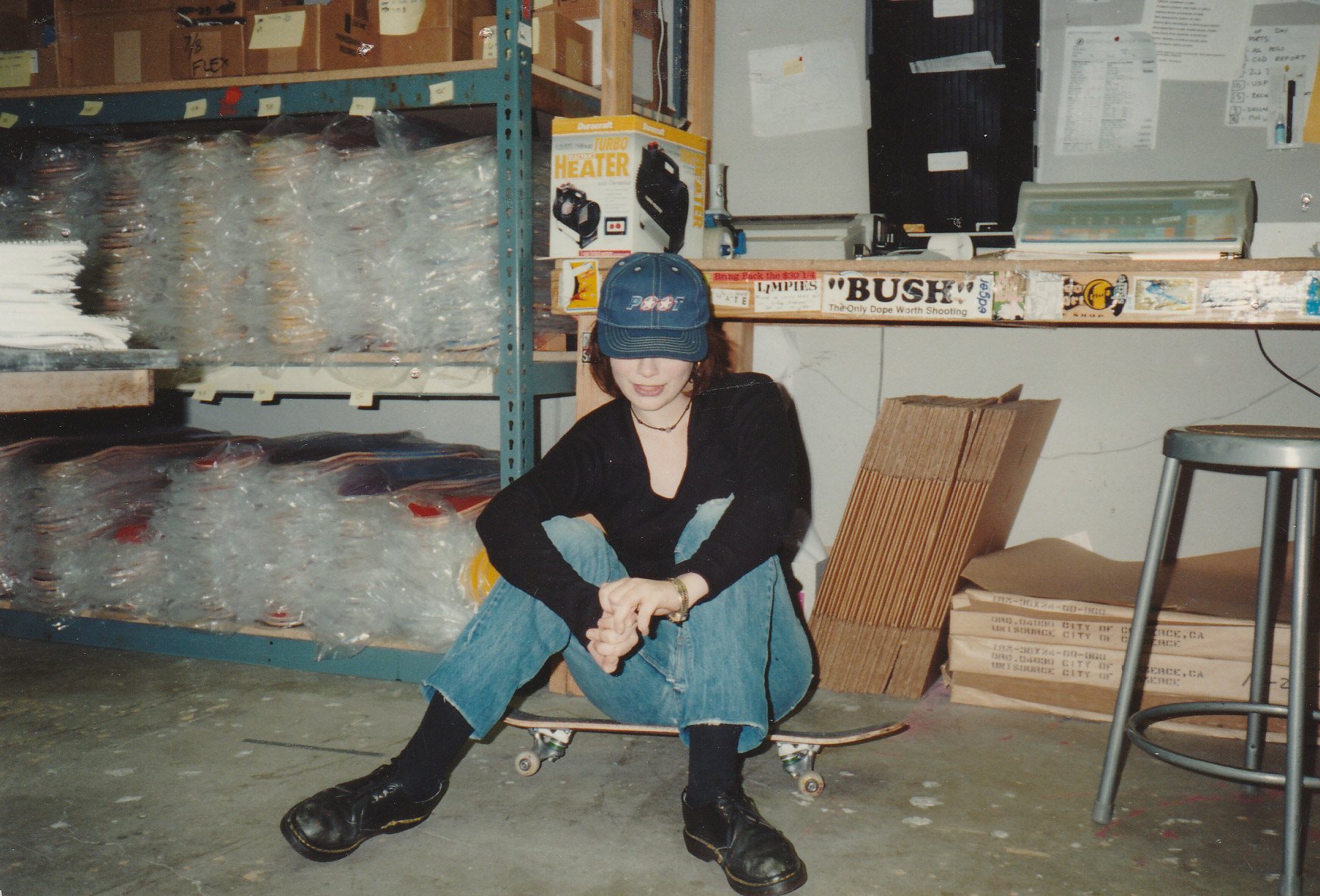
Looking back on Poot! now, and that whole experience, is there anything you wish you did differently?
Oh god, totally! Maybe it would have been good if Tod and I had hired people who had more experience doing production early on. But then maybe that would have killed the wildness of it. It was so unedited and so not commercial and that’s what made it so awesome. But I would have loved for it to live on more. I really think that Poot! could have been so much bigger. I had more designs and more energy to give to the movement. We had a huge fan base and we were just starting to crack the code with being online. I really think we could have turned it into something bigger but we just didn’t have that Quiksilver engine behind us.
Have you thought about bringing it back?
People ask me that all the time but it’s not mine to bring back. Tod owns it all. I came in and we did stuff together but I never owned anything. I wish I had. But would I ever do it again? I think about that all the time but the world has changed. It was very “girl power” back then and now gender identity has evolved and there are all the flavors and colors in between. I just wonder if it would be misconstrued as… I don’t know. That’s what happens — we didn’t overthink things but then when things change and you think about doing something again you think about it too much and it loses the rawness. It’s no longer from the gut. And then I start to think I should just leave it alone. It was alive and it was on fire. Why would we want to mess with it? Just let it be.
“It was so unedited and so not commercial and that’s what made it so awesome.”
Do you keep up with the skate industry at all now?
Not heavily but my husband Tim Dine always skated and still follows everything. My younger son was into skating for a couple of years. I try to keep up with a lot of people. I’m not dissing skateboarding at all but for me it wasn’t about skateboarding itself. It was the movement that was so attractive to me because it was so raw and wild. People were so bold and took risks. If you had an idea you could just do it and explode with creativity. I still follow the business trends and stay in touch with the people who run the companies and who went off and did other things.
Do you think skateboarding still has that rawness and that DIY feel?
I don’t think I’m the right person to answer that. I don’t want to do it injustice because the thing about skateboarding that I always loved so much was that it was true and honest.

Fair enough. What did you do after Poot!?
I did a bunch of other stuff. I almost became a VJ for MTV 2 [laughs]. Aaron Rose — who ran Alleged Gallery and did a bunch of skateboarding art shows — was doing this whole thing for MTV 2 and looking for VJs. I think MTV 2 fizzled out but that almost happened. I have a bunch of footage of me doing ridiculous stuff trying out for it. It was almost like Foxy but I was interviewing people on camera. It would have been so great.
I went on to work as a costume designer on a lot of films and commercials and I loved that. Then I got into advertising and worked at Lambesis, which is now defunct, but we did work for Airwalk, Bebe, Fetish and a bunch of stuff for Levis. Then I got recruited to launch a segment in Jump Magazine called The Jump on Style and did that for a handful of issues. I did a bunch of consulting for other brands and magazines. Then Clea called me one day and said we should write a book together. We ended up getting a book deal with Harper Collins and did this rad book for girls.
Somewhere along the line I got recruited to be an agent for a staffing agency and that’s when I realized that I was a natural agent of some sort. I had been finding Poot! Girls, thinking about who to hire, consulting with other companies. All along I’d kind of been a “recruiter” and so that’s what I do now. I run a recruitment company in the creative industry and help people to find jobs. I started the business in 2001 and 6 weeks later I placed a graphic designer at Rip Curl. DC Shoes called on me. Target, too. I have a rep’ for spotting talent and making connections, but I also work at it. It’s my business and it has been almost 20 years. Kicking ass and takin’ names, one job at a time. So yeah, that’s what I do.
Every once in a while I still get Poot! and Foxy fan email and I wonder if I should redo the Foxy website again. But I have two boys now, and a husband, a dog, a business, and employees, so it’s difficult. But it’s on the list.
Nice! Any words of wisdom you want to pass on before we wrap this up?
It sounds cheesy to say “find your passion” but I believe in finding what you’re into and wearing it like a badge. Don’t hold back. I want girls to be whoever they want to be. You don’t have to be defined by anything. You just fucking go for it, and if you want to be in a space, you claim it!
Interview by Sarah Huston
Photos & archives courtesy of Keva Marie Dine
In a small workshop hidden amongst the busy streets of the Fashion District in Downtown LA, Marissa Martinez — the…
Meow Skateboard's latest guest artist board features the work of Australian designer and skateboarder, Monica Shaw. She took the time…
Pushing Boarders is the world’s only skateboarding conference, connecting a wide range of socially progressive groups and individuals, from emerging…